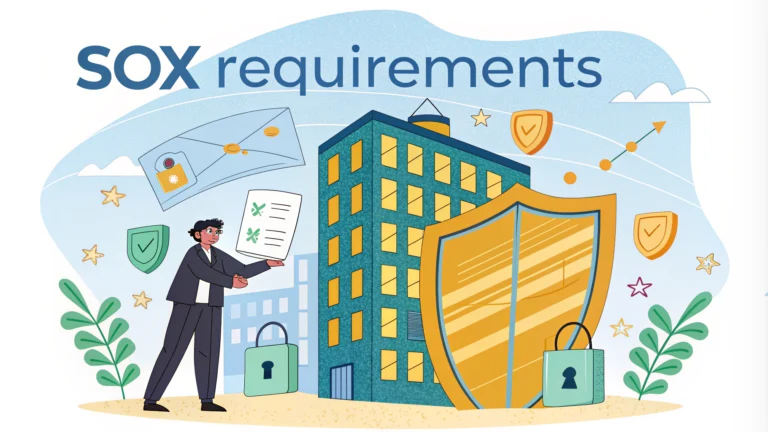SOX compliance for cybersecurity requires regular penetration testing to identify and address security vulnerabilities that could impact financial reporting systems.
Penetration testing plays a key role in meeting SOX Section 404 requirements by validating the effectiveness of internal controls over financial data and systems.
Organizations must document their penetration testing procedures, findings, and remediation efforts as evidence of maintaining adequate security controls.
Core SOX Penetration Testing Requirements
- Annual testing of systems holding financial data
- Documentation of testing methodology and scope
- Assessment of both internal and external vulnerabilities
- Evaluation of access controls and user permissions
- Testing of backup and recovery procedures
- Verification of patch management effectiveness
Testing Scope and Frequency
The scope must include all systems that store, process, or transmit financial information covered under SOX regulations.
| Testing Type | Minimum Frequency | Focus Areas |
|---|---|---|
| External Testing | Annually | Internet-facing systems, remote access |
| Internal Testing | Annually | Network infrastructure, applications |
| Application Testing | Major changes | Financial applications, databases |
Required Documentation
- Test plans and methodologies
- Vulnerability assessment reports
- Remediation tracking logs
- Evidence of control effectiveness
- Management review sign-offs
Best Practices for SOX Penetration Testing
- Use qualified third-party testers for objectivity
- Implement continuous vulnerability scanning
- Maintain detailed remediation tracking
- Test both preventive and detective controls
- Review results with management regularly
Common Testing Tools and Techniques
Standard penetration testing tools like Nessus, Metasploit, and Burp Suite help identify vulnerabilities in SOX-regulated systems.
- Network scanners: Nmap, Wireshark
- Vulnerability scanners: Nessus, OpenVAS
- Web application scanners: Burp Suite, OWASP ZAP
- Password crackers: John the Ripper, Hashcat
Risk Assessment and Reporting
Each identified vulnerability must be assessed based on its potential impact on financial reporting accuracy and integrity.
- Rate vulnerabilities by severity level
- Prioritize fixes based on risk scores
- Document compensating controls
- Track remediation progress
Strengthening Your SOX Security Program
Regular penetration testing should be part of a broader security program that includes continuous monitoring, incident response, and employee training.
Organizations should engage qualified security firms or maintain internal expertise to conduct thorough penetration tests.
For assistance with SOX penetration testing compliance, contact the PCAOB (Public Company Accounting Oversight Board) at 202-207-9100 or visit pcaobus.org.
Testing Result Analysis
Organizations must thoroughly analyze penetration testing results and create detailed reports highlighting:
- Critical vulnerabilities requiring immediate attention
- System weaknesses that could impact financial data
- Failed security controls and misconfigurations
- Recommendations for security improvements
Historical trending of vulnerabilities
Remediation Strategies
Effective remediation planning should follow a structured approach:
- Establish clear timelines for fixing vulnerabilities
- Assign responsibility to specific team members
- Implement and test security patches
- Verify fixes through follow-up testing
- Document all remediation actions taken
Compliance Reporting
Required Reports
- Executive summary for management
- Technical findings report
- Remediation status updates
- Annual compliance attestation
Documentation Requirements
- Test scope and methodology
- Discovered vulnerabilities
- Risk assessment results
- Remediation actions
Maintaining SOX Security Excellence
Successful SOX compliance requires ongoing commitment to security testing and improvement:
- Keep testing procedures current with emerging threats
- Maintain detailed documentation of all security efforts
- Regular review and updates of security controls
- Continuous monitoring of critical systems
- Integration with broader risk management programs
FAQs
- What are the SOX requirements for penetration testing?
SOX requirements mandate regular security testing, including penetration testing, to assess the effectiveness of internal controls over financial reporting systems. While SOX doesn’t explicitly specify penetration testing frequency, it’s typically conducted annually as part of IT general controls. - Which systems need to be included in SOX-compliant penetration testing?
Systems that store, process, or transmit financial data, including general ledger systems, accounting software, payment processing systems, and any applications that impact financial reporting must be included in penetration testing scope. - How often should SOX penetration testing be performed?
Most organizations conduct SOX penetration testing annually, though some perform it semi-annually based on risk assessments. The frequency should align with the organization’s risk profile and any changes to financial systems. - What documentation is required for SOX penetration testing?
Documentation must include detailed test results, identified vulnerabilities, risk assessments, remediation plans, and evidence of fixes implemented. All reports must be retained for audit purposes and should demonstrate the testing methodology used. - Who should perform SOX penetration testing?
Testing should be conducted by qualified independent third-party security professionals or an internal team separate from system administrators. Testers must have relevant certifications and experience in financial system security testing. - What types of penetration testing are required for SOX compliance?
Both external and internal penetration testing should be performed, including network layer testing, application layer testing, and social engineering assessments where relevant to financial systems. - How should vulnerabilities identified during SOX penetration testing be handled?
Vulnerabilities must be risk-rated, documented, and remediated according to their severity. High-risk findings affecting financial reporting systems require immediate attention and should be resolved before the next audit cycle. - What role does penetration testing play in SOX 404 compliance?
Penetration testing is a key component of SOX 404 compliance, providing evidence of effective IT controls and helping identify potential risks to financial reporting integrity. Results are used to demonstrate adequate security controls to auditors. - How should penetration testing results be reported to management?
Results must be reported to management and the audit committee, including executive summaries, detailed technical findings, risk assessments, and remediation recommendations. Reports should clearly link security issues to potential financial reporting impacts. - What are the consequences of inadequate penetration testing under SOX?
Inadequate testing can result in SOX compliance violations, failed audits, potential fines, and increased scrutiny from auditors. It may also lead to material weaknesses in internal controls over financial reporting.







